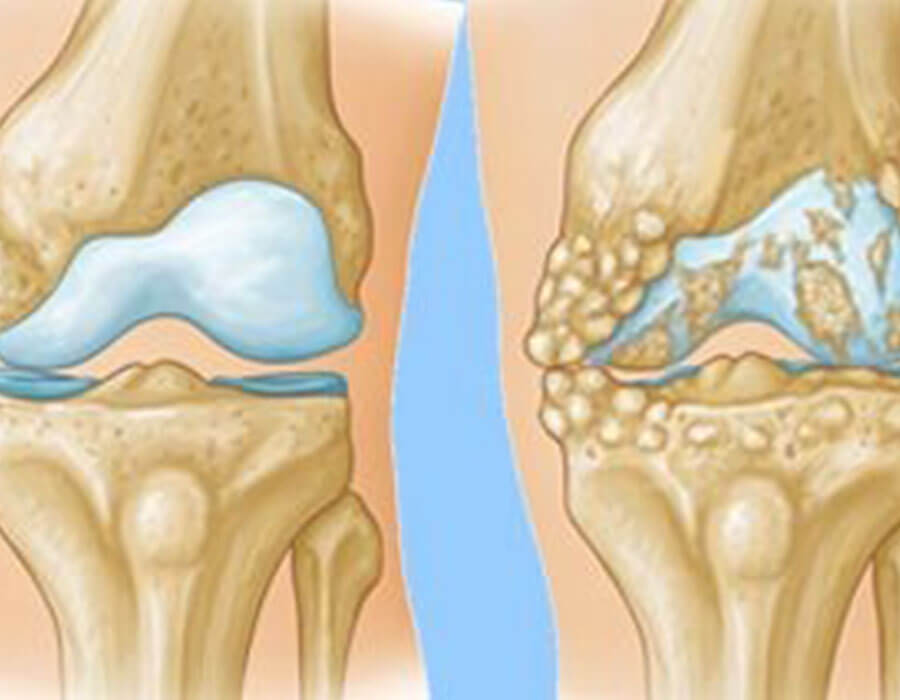Arthritis

What is Arthritis?
Any destruction to any joint cartilage resulting in pain is arthritis. Arthritis is a type of painful joint disorder in which there is swelling and tenderness of one or more joints. There are numerous types of arthritis mainly relating to its cause but commonly seen arthritis are : Degenerative osteoarthritis and Rheumatoid arthritis.
Osteoarthritis causes cartilage (that cushions the ends of the bones) to break down. Rheumatoid arthritis is a disease in which the immune system attacks the lining of the joint capsule which destroys the cartilage of the joint over time.
Treatments vary depending on the type of arthritis. The main goals of arthritis treatment is to reduce symptoms and improve quality of life.
What is Osteoarthritis?
The most common type of arthritis, Degenerative osteoarthritis involves wear-and-tear of the joint cartilage, which cushions the ends of the bones and allows nearly frictionless joint motion, but enough damage to the cartilage exposes the underlying bone which results in bone grinding directly on bone on weight bearing, leads to pain and restricted movement. This wear and tear can occur over many years, or it can be hastened by a joint injury or infection.
Osteoarthritis also causes changes in the bones and deterioration of surrounding soft tissue and muscle that hold the joint together. If cartilage in a joint is severely damaged, the joint capsule may become inflamed and swollen.
What is Rheumatoid arthritis?
In rheumatoid arthritis, the body’s immune system attacks the lining of the joint capsule, a tough membrane that encloses all the joint parts. This capsule (synovial membrane) becomes inflamed and swollen. This disease process can eventually destroy cartilage and bone within the joint. Hence there is deformation of joints leading to pain and arthritis.
Since Arthritis can cause painful restrictive movements and affect your lifestyle, what are the best treatment options available?
In majority of cases, lifestyle modifications, physiotherapy and expert supervised medications and knee joint fluid replacement can help manage knee problems. However, prolonged delay or declining a necessary knee replacement could result in a less favourable outcome. If you have tried medication, physiotherapy, kitchen remedies and suggestions from friends / neighbours and the knee pain is still holding you back from doing the things – it is time to plan a Knee Replacement Surgery.
How do I know if I need a knee replacement?
If you have chronic knee pain that restricts your regular activities like walking, getting up from the chair or floor, constant knee instability, severe deformity of the knee, or If you are dependent on Pain Killers / NSAIDs on regular basis to keep yourself going, then you are likely a good candidate for a total knee replacement.
When is the right time to undergo total knee replacement?
If you’re having trouble getting up to answer the door bell or walk to your car or your Knee Pain is affecting your day to day life style you can seek consultation with our joint replacement expert at OrthoVision Clinic. Any radiological evidence (cartilage mapping) of adequate cartilage damage warrants the need for joint replacement.
What is TKR(Total Knee Replacement)?
Total Knee Replacement (TKR) surgery aims to remove the worn out cartilage and fixes the knee consisting of a artificial femoral part, a tibial part and a patellar part. The femoral part replaces the lower end of thigh bone, ‘femur’. The tibial component replaces upper end of the leg bone tibia’. The knee cap or patella is also replaced with a artificial knee cap.
How many types of implants are available and which one to choose?
Artificial Knee Joints (Implants) come in various types.
An orthopaedic surgeon is the best judge to decide which implant will suit your lifestyle, there are various factors affecting this like Age, Weight, Physiology, Motion Requirement etc.
Does it reduce dependency on Walking-Aid?
Surgery will considerably reduce the dependency of walking aid during post-operative recovery. With a well aligned knee, patients will be able to stand upright and walk normally with minimal walking aid within 2 – 3 days of surgery.